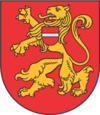Bauska
| Bauska | |||
|---|---|---|---|
| Town | |||
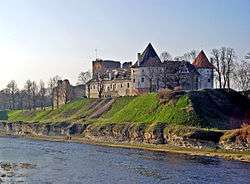 | |||
| |||
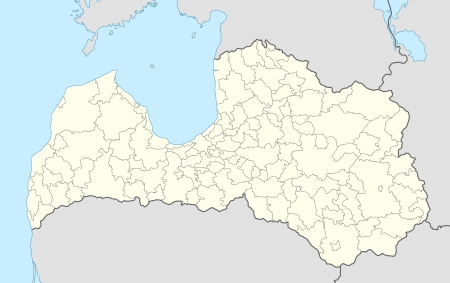 Bauska Location in Latvia | |||
| Coordinates: 56°24′30″N 24°11′35″E / 56.40833°N 24.19306°ECoordinates: 56°24′30″N 24°11′35″E / 56.40833°N 24.19306°E | |||
| Country |
| ||
| District | Bauska Municipality | ||
| Town rights | 1609 | ||
| Government | |||
| • Mayor | Raitis Ābelnieks | ||
| Area | |||
| • Total | 6.3 km2 (2.4 sq mi) | ||
| Population | |||
| • Total | 9,411 | ||
| • Density | 1,493,8/km2 (38,690/sq mi) | ||
| Time zone | UTC+2 (EET) | ||
| • Summer (DST) | UTC+3 (EEST) | ||
| Postal code | LV-390(1-2) | ||
| Calling code | +371 639 | ||
| Number of city council members | 11 | ||
| Website | http://www.bauska.lv/en/ | ||
Bauska (![]()
The town is situated at the confluence of the shallow rivers Mūsa and Mēmele where they form the Lielupe River. Average temperatures in January are -5C, and 17.5C in July. Rainfall averages 500–650 mm annually.
In previous centuries city was known in German as Bauske, in Yiddish as Boisk and in Lithuanian as Bauskė.
History
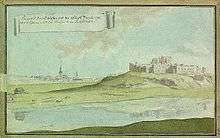
By the early 13th century this territory was inhabited by Semigallian tribes. In the mid-15th century, Bauska castle was built by Germans of the Livonian Order, who then were a part of the Terra Mariana confederacy. In the shadow and protection of the castle a small town called Schildburg grew on the narrow peninsula formed by the Mūsa and Mēmele rivers. Around 1580 on the orders of Duke Gotthard Kettler this settlement was relocated to the present location of Bauska Old Town, eventually receiving city rights sometime before 1609.
After the Livonian War Bauska became part of the Duchy of Courland and Semigallia and prospered. The castle and city suffered heavily in the 17th and 18th centuries, under attacks from Sweden in the Polish-Swedish War and the Russians in the Great Northern War. In 1706. retreating Russians blow up the castle. In 1711 an outbreak of plague ravaged Bauska, exterminating half of the population, and war returned once more in 1812, when Bauska, after short skirmishes, became one of Napoleon's army's transit points en route to Moscow.
Between 1812 and 1914, Bauska enjoyed a period of stability, and grew as a trade center between Riga and Lithuania. Many inhabitants were merchants or worked in ceramic-making, but there was a large brewery and sawmill as well. Bauska was still primarily built of wooden houses: in 1823, only 6 of the 120 houses within the city were built of brick or stone. For this reason, devastating fires were not uncommon.
Historically, all social affairs had been in the hands of the privileged Baltic Germans. After 1820 Jews were allowed to settle in the city, and by 1850 made up half the population, diluting the strong German influence.
The city was taken by the German Imperial Army on July 18, 1915, and roughly half the population fled (Jews were moved out on the orders of the Russian army). In 1916, the Germans installed the city's first electrical grid and built a narrow-gauge railway connection with Jelgava–Meitene Railway.
During the Latvian War of Independence Bauska experienced a couple of months of Red Army occupation, followed by the periods of rule by the Baltische Landeswehr and West Russian Volunteer Army until it was liberated in the early hours of November 17, 1919 by the Latvian army.
From 1918 to 1940, the proportion of ethnic Latvians in the population grew strongly, making up 75% of the population, though the Jews and Germans still maintained a noticeable presence. In 1939, just before World War II, virtually the entire Baltic German population of Bauska repatriated to the recently occupied Reichsgau Wartheland, causing the city to lose one of its traditional ethnic populations. As part of the Holocaust during the June–August 1941, Bauska's other traditional minority, the Jews were exterminated.
During the Operation Bagration Soviet army reached Bauska on July 29, 1944. For the next six weeks city was defended by assortment of Latvian policemen, forcibly mobilized Latvian Legion soldiers and Wehrmacht grenadiers. After Soviet shelling and air raids almost one third of the city was destroyed and finally captured on September 14, 1944.
Post-war reconstruction was slow. Rubble remained in the streets until the 1950s. During the Soviet period, the population surpassed 10,000, as the Latvian and especially Russian populations strongly increased.
- Bauska Church of the Holy Spirit the oldest building in town
- Bauska Town Hall in the Market square
- 19th century buildings on Riga street
- Stalin era cinema building
 Suspension bridge over Mūsa
Suspension bridge over Mūsa Bauska Bus Station
Bauska Bus Station
Demographics
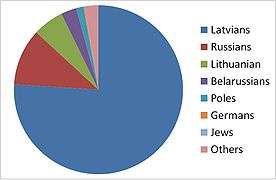
In December 2004, there were 10,178 inhabitants, 55% female and 45% male.
Jewish community
Bauska was home to a thriving Jewish community in the 19th century,[1] many employed as scholars or in occupations such as baking and distilling. The town hosted several notable rabbis, including Abraham Isaac Kook, later chief rabbi of Israel, Mordechai Eliasberg, and Chaim Yitzchak Bloch Hacohen.[2]
In 1850, Jews made up 50% of Bauska's population, and 60% in 1881.[3] By 1920, the Jewish population had dwindled to about a sixth of the size it had been 40 years earlier.[4] In 1941, following the Nazi invasion, the remaining Jews of Bauska and environs were tortured and executed.[5]
An exhibition on the city's Jewish history was opened in 2011 in Bauska museum[6] following a conference on Bauska's Jewish cultural heritage in the 1990s. A group of Jews who were former inhabitants of Bauska proposed to establish a memorial on the site of the synagogue that was burnt down in July 1941 but so far have been refused by the City council.[7]
Bauska's Defenders' Monument
On September 14, 2012, a monument to the inhabitants of city who organized the defense of Bauska against the Soviet assault in 1944 was unveiled in the city, with inscription "To the defenders of Bauska against the second Soviet occupation on July 28 – September 14, 1944". This event was represented by Russian language media as glorification of Nazism in Latvia.[8]
Notable people
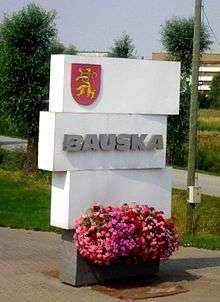
- Friedrich Bernhard Albers, 18th century silversmith.[9]
- Karl Constantin Kraukling, (1792-1873), Director of the Royal History Museum, Dresden.[10]
- Arthur Böttcher, (1831 – 1889), pathologist and anatomist.
- Lazar Nisselovich, (1858-1914), member of the 3rd Russian Duma.
- Abraham Isaac Kook, (1865-1935), Bauska rabbi 1894-1904.
- Vilis Olavs, (1867-1917), active during Latvian National Awakening.
- Vilis Plūdons, (1874-1940), poet.
- Krišjānis Berķis, (1884-1942), general, Minister of War.
- Kristīne Nevarauska, (born 1981) actress.
- Ivars Timermanis, (born 1982), basketball player.
- Mārtiņš Podžus and Jānis Podžus, (born 1994), tennis players.
Places to see
- Bauska castle and museum.[11]
- Bauska Church of the Holy Spirit, Lutheran.,[12][13]
- Bauska Town Hall.,[14][15]
- Bauska museum.[16]
- Bauska Freedom monument.[17]
- Church of St. George, Orthodox.[18]
- Bauska Church of the Most Holy Sacrament, Catholic.,[19][20]
- Stone of Peter the Great.[21]
Sister cities
External links
References
- ↑ Bauska, Latvia
- ↑ L Dribins, A Guttmanis, and M Vestermanis, "Latvia's Jewish Community: History, Tragedy, Survival", Ministry of Foreign Affairs of the Republic of Latvia, ca. 2001.
- ↑ "The Jewish Community of Bauska". The Museum of the Jewish People at Beit Hatfutsot.
- ↑ JewishGen
- ↑ The Murder of the Jews in Latvia: 1941-1945
- ↑ Jews in Bauska
- ↑ Bauska memorial Archived 2015-12-27 at the Wayback Machine.
- ↑ Monument to Waffen SS Latvian Legion unveiled in Latvia
- ↑ Christies.com
- ↑ Karl Constantin Kraukling
- ↑ Bauska Castle and Museum
- ↑ Church of Holy Spirit Archived November 2, 2015, at the Wayback Machine.
- ↑ Church of the Holy Spirit
- ↑ Bauska Town Hall
- ↑ Bauska City Hall
- ↑ Bauska Museum
- ↑ Freedom monument
- ↑ Panoramio.com
- ↑ St.Sacrament church
- ↑ Photos
- ↑ Stone of Peter the Great

